Collection of materials relating to neuro-ophthalmology as part of the Neuro-Ophthalmology Virtual Education Library.
NOVEL: https://novel.utah.edu/
TO
- NOVEL969
Filters: Collection: "ehsl_novel_novel"
| Title | Creator | Description | Subject | ||
|---|---|---|---|---|---|
| 1 |
 |
Genetic Causes of Isolated Optic Neuropathy | Kathleen Ho; Devin Mackay | Overview of isolated genetic optic neuropathies and their neuro-ophthalmic manifestations with an illustrative case example and discussion of clinical presentation, relevant biochemistry, and testing. | Genetics; Hereditary; MFN2; NDUFV1; OPA1; OPA3; Optic Atrophy; Optic Neuropathy; POLG; SPG7; WFS1 |
| 2 |
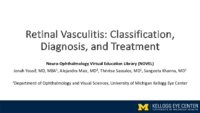 |
Retinal Vasculitis: Classification, Diagnosis, and Treatment | Jonah Edward Yousif; Alejandra M. Maiz; Thérèse Maria Sassalos; Sangeeta Khanna | This manuscript discusses retinal vasculitis and its classification, diagnosis, and treatment. We first discuss the definition and symptoms of retinal vasculitis followed by its classification as a small-vessel vasculitis compared to large and medium vessel vasculitides. Following this, we describe ... | Fluorescein Angiography; Retina; Retinal Vasculitis; Uveitis; Vasculitis |
| 3 |
 |
Macular Edema | Stephanie Chau Nguyen; James Brian Davis; Amanda Dean Henderson | Macular edema can result from pathologic extravasation of fluid through blood vessels in the macular region. This can be a feature of heritable diseases like dominantly inherited cystoid macular edema or acquired causes such as diabetic retinopathy, hypertensive retinopathy, retinal vein occlusions,... | Anti-VEGF; Diabetes; DME; Macular Edema; OCT |
| 4 |
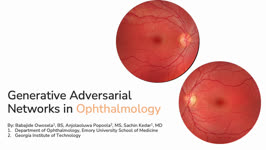 |
Generative Adversarial Networks in Ophthalmology | Babajide Olubusayo Owosela; Anjolaoluwa Popoola; Sachin Kedar | In this video we will describe Generative Adversarial Networks (GAN) models and its applications and limitations in Ophthalmology. GAN, a technique within machine learning, enables computers to utilize real data to generate valuable synthetic data, artificially produced information that mimics the s... | Artificial Intelligence; Generative Adversarial Networks; Machine Learning; Synthetic Data |
| 5 |
 |
NANOS Illustrated Curriculum Section B Introduction | Jason Peragallo, MD | Introduction video to the resources available in Section B of the NANOS Illustrated Curriculum. | Afferent visual pathway; Efferent visual pathway, Pupillary visual pathway; Examination |
| 6 |
 |
Age Related Macular Degeneration | Riya H. Patel; James Brian Davis; Amanda Dean Henderson | Age-related macular degeneration (AMD) is a degenerative disease of the retina that causes central vision loss, and it is the leading cause of blindness in the developed world. Age is a strong nonmodifiable risk factor for AMD. Patients may have genetic susceptibility to AMD from mutations in genes ... | AMD; AREDS2; Exudative; Geographic Atrophy; Macular Degeneration; Nonexudative |
| 7 |
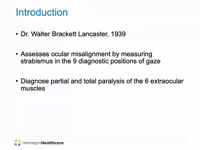 |
Lancaster Red-Green Test | Angela Cao; Anne Abel | The Lancaster Red Green Test is used to assess ocular misalignment. This brief video explains how to administer and interpret the test. | Diplopia; Lancaster Red Green Test; Strabismus |
| 8 |
 |
Paraneoplastic Anti-Hu and Anti-CV2 Positive Ataxic (Cerebellar and Sensory Ganglionopathy) Encephalitis | Anuj Rastogi; Rahul Sharma; Gustavo Saposnik; Alexandra Muccilli | We describe a case of an elderly man with Non-small Cell Lung Cancer, presenting with paraneoplastic Anti-Hu and Anti-CV2 positive encephalitis. He had both cerebellar ataxia and sensory ataxia, likely from the paraneoplastic induced cerebellar degeneration and sensory ganglionopathy, respectively. ... | Anti-CV2; Anti-Hu; Ataxia; Cerebellar Ataxia; Encephalitis; Nystagmus; Sensory Ganglionopathy |
| 9 |
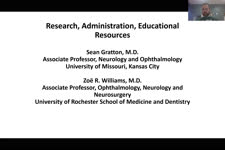 |
NANOS Illustrated Curriculum Section H Introduction | Sean Gratton, MD; Zoë R. Williams, MD | Introduction video to the resources available in Section H of the NANOS Illustrated Curriculum. | History, Neuro-ophthalmology; Principles of Practice, Neuro-Ophthalmology; Systems of Healthcare; Research, Neuro-ophthalmology |
| 10 |
 |
NANOS Illustrated Curriculum Section D Introduction | Meagan D. Seay, DO; Victoria S. Pelak, MD | Introduction video to the resources available in Section D of the NANOS Illustrated Curriculum. | Lesions, Afferent Visual Pathway; Disorders, Afferent Visual Pathway; Pupillary Anatomy; Disorders, Pupillary Function; Lesions, Efferent Visual Pathway; Ocular Motility; Abnormal Eye Movements; Eyelids; Abnormal Facial Movements |
| 11 |
 |
NANOS Illustrated Curriculum Section G Introduction | Meagan D. Seay, DO | Introduction video to the resources available in Section G of the NANOS Illustrated Curriculum. | Obesity, Management; Low Vision, Management; Genetic Diseases, Management; Patient Counseling |
| 12 |
 |
Facioscapulohumeral Muscular Dystrophy (FSHD) | Rohith Erukulla; Brooke Johnson | This is an introduction to Facioscapulohumeral Muscular Dystrophy (FSHD) and its causes, presentation, diagnosis, treatment, and ongoing related research. | Dystrophy; Facioscapulohumeral Muscular Dystrophy; FSHD; Myopathy |
| 13 |
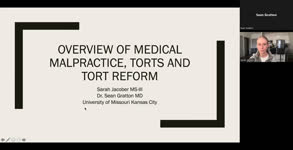 |
Overview of Medical Malpractice, Torts, and Tort Reform | Sarah Jacober; Sean Gratton | This is a brief narrated powerpoint, which serves as an introduction to the basics of medical malpractice. The definition and history of medical malpractice are explored. The relationship between medical malpractice and tort law are explained, and tort reform is introduced. | Lawsuit; Malpractice; Medical Malpractice; Medicolegal; Tort Reform; Torts |
| 14 |
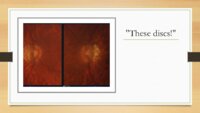 |
Tilted-Disc Syndrome (TDS) - Understanding the Basics | Ahmed Alshaikhsalama; Melanie Truong-Le | This submission is a powerpoint summarizing the literature on a poorly understood disorder known as Tilted Disc Syndrome (TDS). Delving into the fundamental aspects of TDS, this resource meticulously digests complex medical literature to inform readers on the epidemiology, risk factors, complication... | Coloboma; Inferior Crescent; Tilted Disc Syndrome |
| 15 |
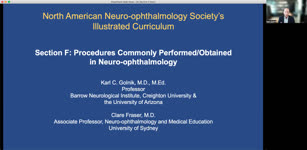 |
NANOS Illustrated Curriculum Section F Introduction | Karl C. Golnik, MD, MEd; Clare Fraser, MD | Introduction video to the resources available in Section F of the NANOS Illustrated Curriculum. | Surgery, Ophthalmic; Surgery, Neurological; Non-surgery procedures; Neurosurgery; Interventional neuroradiology; Neuro-ablation; Neuro-stimulation; Intraocular surgery; Botulinum toxin therapy |
| 16 |
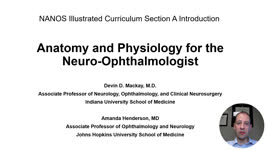 |
NANOS Illustrated Curriculum Section A Introduction | Devin D. Mackay, MD; Amanda D. Henderson, MD | Introduction video to the resources available in Section A of the NANOS Illustrated Curriculum. | Anatomy, Visual Pathways; Anatomy, Eye; Anatomy, Orbit; Anatomy, Intracranial; Anatomy, Orbital Vascular; Cerebrospinal fluid |
| 17 |
 |
Diagnosis and Evaluation of Stroke in the Pons | Padmaja Sudhakar; Fatai Momodu | This short power point describes the anatomy of the pons, followed by description of stroke in the pons along with clinical presentation and work up. | Crossed Signs; One and Half Syndrome; Pontine Stroke |
| 18 |
 |
Financial Social Legal Implications of Genetic Testing | Jonathan Thomas; James Brian Davis | Genetic testing looks for mutations in DNA and can give insight into genetic diseases. Costs associated with genetic testing are the testing itself, as well as genetic counseling. Test results may lead to further considerations, which may impact finances. Genetic test results can have a social impac... | Financial; Genetic Information Nondiscrimination Act of 2008; Genetic Testing; Legal; Social |
| 19 |
 |
Injury Prevention in the Visually Impaired | Jonathan Thomas; James Brian Davis; Amanda Dean Henderson | With an aging population in the US, the number of those with visual impairments is also rising. Visual impairments increase the risk of falls, injuries, and other deficiencies, but there are several potential strategies to prevent these injuries. Members of the healthcare team can help visually impa... | Fall; Injury Prevention; Low Vision Specialist; Visually Impaired |
| 20 |
 |
Hydroxychloroquine Retinopathy | Zoe Rebecca Williams, MD; David Allen DiLoreto Jr., MD | This powerpoint reviews hydroxychloroquine retinopathy including the clinical findings and the updated American Academy of Ophthalmology screening guidelines (revised in 2016). It includes images depicting the typical paracentral visual field loss, spectral domain optical coherence tomography findin... | AAO Screening Guidelines; Fundus Autofluorescence; Hydroxychloroquine Retinopathy; Outer Nuclear Layer Loss; Photoreceptor Loss; Retinal Pigment Epithelium Loss; Spectral Domain Optical Coherence Tomography |
| 21 |
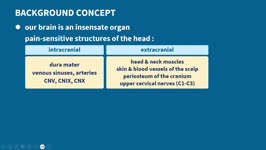 |
Headache Associated With Low or High Intracranial Pressure | Yu Hsin Chen; Amanda Dean Henderson; James Brian Davis | When intracranial pressure changes, the most common symptom is headache, which often has a positional component. We introduce various etiologies of headaches attributed to increased or low intracranial pressure, with idiopathic intracranial hypertension (or primary pseudotumor cerebri), post-dural p... | CSF Leak; Headache; Intracranial Hypertension; Intracranial Hypotension; Papilledema; Pseudotumor Cerebri |
| 22 |
 |
A Case of Left Facial Pain Misdiagnosed as Migraine Headache | Hong Jiang | A 58-year-old female sought a second opinion due to a two-year duration of sporadic left facial pressure pain, along with irritation and dryness in her left eye. She has a well-documented history of episodic migraines characterized by throbbing headaches on the right side. She had been under the car... | Dry Eye; Facial Nerve Schwannoma; Facial Pain |
| 23 |
 |
Trigeminal Autonomic Cephalgias | Kaitlin Keenan; Aimee J. Szewka | These slides are a comprehensive discussion addressing Trigeminal Augonomic Cephalgias - in particular, Cluster Headaches, Paroxysmal Hemicrania, Hemicrania Continua and Short-Lasting Unilateral Neuralgiform Headache Attack (SUNHA). Our slides discuss diagnosis, prognosis and treatment of these rare... | Cluster Headache; Headache; Hemicrania Continua; Paroxysmal Hemicrania; Short-Lasting Unilateral Neuralgiform Headache Attack; Trigeminal Autonomic Cephalgia |
| 24 |
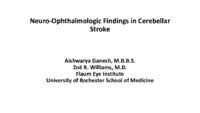 |
Neuro-ophthalmologic Findings in Cerebellar Stroke | Zoe Rebecca Williams; Aishwarya Ganesh | This PowerPoint reviews the anticipated neuro-ophthalmologic findings in cerebellar strokes including posterior inferior cerebellar artery (PICA), anterior inferior cerebellar artery (AICA) and superior cerebellar artery (SCA) territory infarcts. The review includes discussion of potential ocular mi... | AICA; Cerebellar Esotropia; Cerebellar Infarct; Lateral Medullary Syndrome; Nystagmus; Ocular Lateropulsion; PICA; SCA; Skew Deviation |
| 25 |
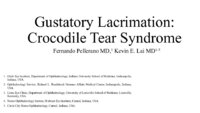 |
Gustatory Lacrimation: Crocodile Tear Syndrome | Fernando Pellerano; Kevin Lai | We describe a case of gustatory lacrimation on a 61-year-old male with a history of Bell's Palsy that presented to the Ophthalmology clinic with painless epiphora in the right eye while eating. Examination was notable for oral-ocular synkinesis and hyperlacrimation while eating on the right eye only... | Crocodile Tear Syndrome; Gustatory Lacrimation; Oral-ocular Synkinesis |
